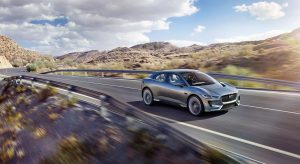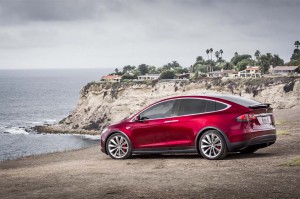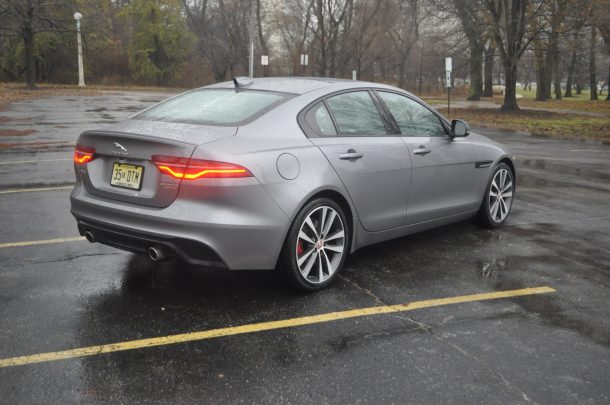
The I-Pace was Jaguar’s first all-electric model. The J-Pace is expected to be bigger – and may also offer hybrid and plug-in powertrain options.
With the launch of the I-Pace, Jaguar became one of the first automakers to deliver an all-electric model in luxury car territory. Now, the British brand is readying its second battery-electric vehicle, the even larger J-Pace.
Expected to arrive later in the 2021 model year, the Jaguar J-Pace will be go up against other premium midsize SUVs, such as the BMW X5, Mercedes-Benz GLE and, in particular, the Tesla Model X.
The automaker hasn’t said much about its plans for the J-Pace, just confirming that additional battery-electric vehicles are in the works. But set to be its second entry into the BEV market, it will be both larger than the current Jaguar I-Pace and longer range, thanks to a battery pack expected to store about 100 kilowatt-hours.
(Jaguar keeps celebrating E-type’s 60th anniversary with unique F-Type.)
That’s in line with the longest-range version of the Model X which can deliver an EPA-rated 348 miles per charge. But whether Jaguar’s electric driveline can match its rival’s efficiency remains to be seen. Currently, Jaguar gets an EPA rating of just 234 miles out of a 90 kWh pack with the smaller I-Pace.

The coming J-Pace will be comparable to the Tesla Model X, although the Model X has a longer range, but changes by Jaguar could change that.
The J-Pace, however, could manage a bit more as it will be using an all-new platform that also will underpin other Jaguar Land Rover battery-electric vehicles. That will include the next-generation Jaguar XJ, along with a future version of the Range Rover. JLR has confirmed the all-electric sedan but only hinted at full electrification plans for the Land Rover side of the company.
It has, nonetheless, made it clear that its future will involve electric drivetrain technology pretty much across the board. But that will include hybrid technology – and plug-ins, in particular – as well as all-electric vehicles.
Significantly, the new platform set to underpin the XJ and J-Pace has been designed to accommodate both full battery-electric drivelines as well as hybrid and traditional gas-powered systems. Some speculation centers around a possible debut of JLR’s new inline-six-cylinder engine with the launch of the J-Pace. Most likely, however, it would be used as part of a plug-in hybrid system with a smaller battery pack than the all-electric version of the J-Pace.
Whatever the final options Jaguar offers, it takes a distinctly different approach from the direction Jaguar took with the I-Pace, its first BEV. That model is offered only with a battery drive system.
(Jaguar offering new, but old electric vehicle: E-type Zero.)
Adopting a flexible architecture has its advantages: it allows a manufacturer to mix and match powertrains, depending upon market demand, without having to develop separate platforms.

The new J-Pace will likely share its platform and dimensions with the Range Rover Sport, but get a very different look.
But there are numerous compromises to such a design. All-electric architectures tend to resemble oversized skateboards, optimized to have motors, batteries and other key components mounted below the load floor. Among other things, they tend to have lower centers of gravity and good front-to-rear weight distribution. But that changes when you need space up front for a possible gas engine.
The Jaguar I-Pace, in particular, took advantage of its electric-only design by recapturing some of the space normally required for an internal combustion engine, repurposing it for passengers and cargo.
Nonetheless, the J-Pace is expected to pick up many of the distinctive design cues of the I-Pace, albeit with a somewhat longer nose.
It will offer more interior space and more high-line features, according to various sources. There will be an emphasis on technology, including a version of the Duo Pro touchscreen infotainment now offered on the most recent JLR entries. That system uses twin SIM-based communications systems to enhance its speed. One is used for such things as downloading mapping and traffic info, while also being able to handle smartphone-style over-the-air updates for the vehicle’s software.
(2021 Jaguar E-Pace gets “thorough freshening.”)
While Jaguar is expected to continue using internal combustion technology, how long it will do so is unclear. It may follow a path similar to that of Volvo which expects to continue relying on plug-in and BEV systems, at least through the end of the decade. But the British brand has begun signaling that it could go entirely electric beyond 2030. Considering that’s the year that Great Britain now plans to ban sales of new vehicles using internal combustion engines, that would clearly make sense.






